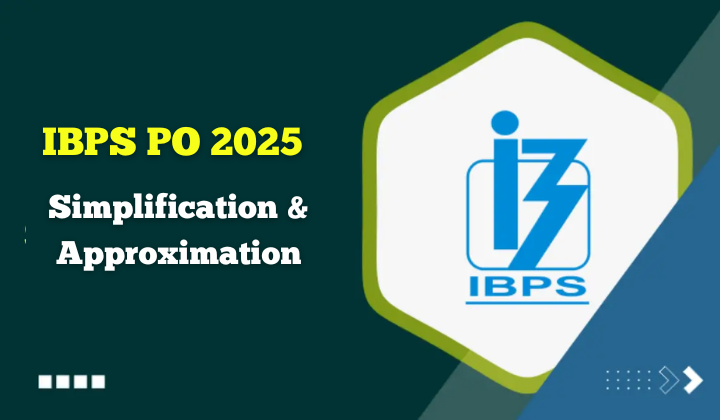Simplification and Approximation are among the most scoring topics in the Quantitative Aptitude section of the IBPS PO Exam 2025. These questions test a candidate’s speed and accuracy in basic arithmetic operations. With proper practice and the right tricks, aspirants can solve these questions quickly, saving valuable time for tougher problems in the exam. This section plays a key role, especially in the Prelims, where time management is critical, and every mark counts toward clearing the cut-off.
Simplification and Approximation for IBPS PO Exam 2025
Simplification questions involve solving for exact values using mathematical operations, while approximation questions test your ability to quickly estimate answers without calculating exact figures. These topics help save valuable time in the exam and are usually high scoring if practised well. Understanding number operations, the BODMAS rule, and decimal approximation is essential to excel in these questions.
Types of Questions Asked
- Basic Arithmetic (BODMAS Rule)
- Surds and Indices
- Decimals and Fractions
- Square roots and Cube roots
- Percentage-based expressions
- Approximate calculations with large numbers
- Use of ‘~’ or ‘approximately equal to
1. Basic Arithmetic (BODMAS Rule)
- Nature of Questions: These involve evaluating expressions using the correct order of operations Brackets, Orders (powers and roots), Division, Multiplication, Addition, and Subtraction.
- Example:
- Simplify: 15+[6÷(2×3)]−4
Accuracy in applying the rule. Often appears in simplification problems and number series. Focus on inner brackets first. Mistakes usually happen due to ignoring precedence.
2. Surds and Indices
Questions based on laws of exponents and simplification of irrational numbers.
- Example:
- Simplify: √3×√12 or (23)2÷22
Conceptual clarity in simplifying roots and applying exponent rules. Memorize basic laws of exponents and convert roots into powers wherever possible.
3. Decimals and Fractions
Convert fractions to decimals or vice versa, compare values, or perform operations like addition/subtraction.
- Example:
- Which is greater: or 7/10
Speed in converting and comparing; crucial for approximation and number series. Know common fractions and their decimal equivalents (e.g., 13=0.333\frac{1}{3} = 0.333).
4. Square Roots and Cube Roots
Find square or cube roots of perfect or near-perfect numbers.
- Example:
- Find the value of √625 or estimate √50.
Speed and accuracy in recognizing perfect squares/cubes and estimating roots. Memorize squares up to 30 and cubes up to 20. For non-perfect squares, use nearby values.
5. Percentage-based Expressions
- Often seen in simplification and DI. You’re asked to find percentages of values or combine multiple percentage operations.
- Example:
- Simplify: 25% of 480 + 12.5% of 320
Rapid percentage calculation and application in arithmetic and DI. Use fraction equivalents: 25%=1/4, 12.5%=1/8
6. Approximate Calculations with Large Numbers
Used in approximation-based simplification problems or DI. Round off large numbers and perform basic arithmetic.
- Example:
- Approximate 6397÷24.9
Ability to estimate answers quickly while maintaining reasonable accuracy. Round 6397 to 6400 and 24.9 to 25 ⇒ 6400/25=256
7. Use of ‘~’ or ‘Approximately Equal To’
Involves interpreting expressions like 50≈7.1 or π≈3.14
- Example:
- Which of the following is approximately equal to √200? Options may include values like 13.8, 14.1, etc.
Logical reasoning and comfort with estimates instead of exact values. Don’t over-calculate. Use benchmark values to eliminate options quickly.
Simplification and Approximation Questions for IBPS PO Exam 2025
Direction (01– 05): What value should come in the place of question (?) mark?
Q01. 12% of 750 + 16% of 1250 = ?² + ³√1
(a) 15
(b) 17
(c) 21
(d) 23
(e) 16
Q02. 1364 + ?³ = 40% of 3950
(a) 7
(b) 5
(c) 8
(d) 6
(e) 4
Q03. (768/?) + 12³ = 120% of 1480
(a) 16
(b) 12
(c) 14
(d) 24
(e) 20
Q04. ?% of 240 + 56% of 450 = 50% of 588
(a) 7.5
(b) 12.5
(c) 17.5
(d) 20
(e) 22.5
Q05. 72% of ? + √784 = 282
(a) 1150
(b) 1050
(c) 850
(d) 950
(e) 750
Direction (06-10): What approximate value should come in the place of question (?) mark:
Q06. ? % of 224.99 + 19.01 % of 699.98 = (15.99)² – 30.01% of 289.99
(a) 18
(b) 16
(c) 12
(d) 10
(e) 8
Q07. ?³ + (18.01)² = 59.99% of 899.93
(a) 5
(b) 4
(c) 2
(d) 6
(e) 3
Q08. ](87.01 x 7.98) / ?]+ 7.99% of 1149.98 = (18.01)2
(a) 3
(b) 27
(c) 12
(d) 6
(e) 9
Q09. (2)^? % of 499.99 + √1296.01= (13.98)²
(a) 4
(b) 2
(c) 5
(d) 6
(e) 3
Q10. ?² + 439.08 – 40.011% of 899.99 = 7.99% of 2500.008
(a) 9
(b) 11
(c) 16
(d) 13
(e) 12
| Answers | |||||||||
| 01 | 02 | 03 | 04 | 05 | 06 | 07 | 08 | 09 | 10 |
| b | d | a | c | b | b | d | a | c | b |
Common Question Types:
- Simplifying large expressions using BODMAS rules.
- Approximation of complex calculations by rounding numbers.
- Estimation of square roots, cubes, percentages, and other mathematical operations.
Tips for Solving Simplification and Approximation Questions:
- Speed is key: Practice makes perfect. The faster you get at simplifying numbers and approximating values, the better you’ll perform in the exam.
- Avoid overcomplicating: Always look for the simplest method to solve each problem.
- Check the options: Sometimes, approximation questions give you options that can help you choose the correct answer faster.
| Related Post | |
| Reading Comprehension Tips for IBPS PO Exam |
|
| IBPS PO Exam Date | IBPS PO Syllabus |
| IBPS PO Preparation Strategy | IBPS PO Salary |
| IBPS PO Eligibility | IBPS PO Mock Test |




 Computer Questions Asked in IBPS RRB PO ...
Computer Questions Asked in IBPS RRB PO ...
 IBPS RRB Officer Scale 2 Exam Analysis 2...
IBPS RRB Officer Scale 2 Exam Analysis 2...
 IBPS RRB PO Mains Expected Cut Off 2025,...
IBPS RRB PO Mains Expected Cut Off 2025,...







